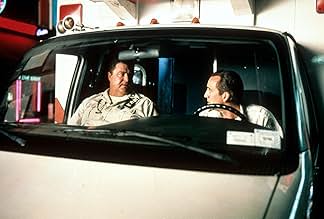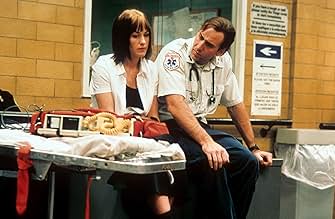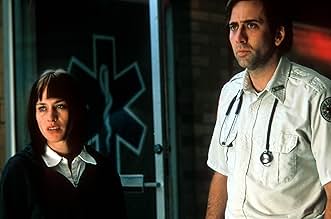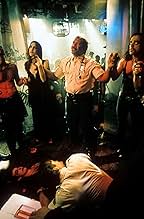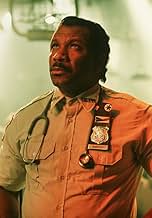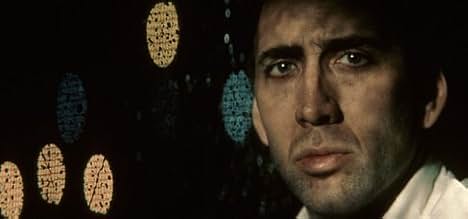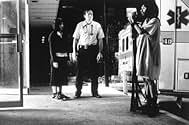Atormentado por los pacientes que no pudo salvar, un paramédico de Manhattan lucha para mantener la cordura durante tres noches turbulentas.Atormentado por los pacientes que no pudo salvar, un paramédico de Manhattan lucha para mantener la cordura durante tres noches turbulentas.Atormentado por los pacientes que no pudo salvar, un paramédico de Manhattan lucha para mantener la cordura durante tres noches turbulentas.
- Dirección
- Guionistas
- Elenco
- Premios
- 2 premios ganados y 5 nominaciones en total
- Mr. Burke
- (as Cullen Oliver Johnson)
- Captain Barney
- (as Arthur Nascarella)
- Dirección
- Guionistas
- Todo el elenco y el equipo
- Producción, taquilla y más en IMDbPro
Opiniones destacadas
Overall, Bringing Out the Dead appears to be heavily influenced by film noir. Frank, the protagonist, is at the end of his rope in a rather solitary and stressful job and he often finds escape from the ghosts of his failures through alcohol. Patricia Arquette plays Mary, the femme fatale character and woman in distress Frank seeks to save. The film is uber-urban, set mainly in the nighttime ghettos and hustling districts of New York City, and the major events center around various city dwellers. Frank's adventures in life saving are highlighted by the colorful characters of City life, including prostitutes, drug addicts, homeless persons, insane persons, goth-punk death rockers and the ubiquitous 'Mr. O.,' the smelliest destitute to plague Our Lady of Perpetual Mercy Hospital. Frank is led by Mary into the narcotic underworld, and meets the proprietor of 'The Oasis,' a charismatic dealer with a passion for tropical fish and silk robes.
Many of the lighting techniques also serve to emphasize the urbanality of the surroundings, often combining music and fast paced editing. The darkness of the City night is contrasted with the searing halogen of the hospital, and the sunlight that creeps through the window at dawn mocks Frank's insomnia. Indeed, the movie ends at dawn, with Frank nodding off to sleep. This is very similar to the traditional horror movie ending at dawn when the nighttime monsters are relegated to their nocturnal lairs. Editing techniques are feverish and accelerate in pace as the movie progresses and Frank's hysteria mounts. Many of these sequences involve a montage of the flashing ambulance lights, 360-degree camera rotation, blurred traffic lights and shots of the crazed driver behind the wheel. My personal favorite scene is when Frank is going to answer a call, and the montage is set to R.E.M.'s What's the Frequency Kenneth.
Overall, most of the main characters are the male ambulance drivers/EMTs. These characters, Frank, Tom, Marcus and Larry, exude a kind of unquestioned masculinity, which they prove through various means such as violence, excessive flirting, and alcohol consumption. Tom is a violent, hair trigger macho who enjoys pummeling transients and minorities. Marcus is a smooth talking black man who chain smokes stogies and praises Jesus. Larry is an overweight everyman, wanting to start his own paramedic business. Frank is a Marlboro smoking altruistic cowboy with a drinking problem and insomnia. At some point, most of the characters engage in drinking (liquor) while on duty or at least in the ambulance. The characters names are also quite masculine, especially in contrast to Noel, a man who is a drug addict of ethnic descent that is never arguably fully a man.
Inherently, Scorsese's New York City is an urban jungle that will break any man who is not strong or tough enough.
The film focuses on a paramedic called Frank played by Nicolas Cage. The film focuses on 48 hours of Frank's life as a paramedic and all the horrific things he has seen. As well as that Frank is also haunted by spirits of people who he couldn't save, befriends a young women called Mary played by Patricia Arquette and a whole range of strange partners.
The actors that Scorsese has chosen are a weird bunch as they're not really in Scorsese's other films and they're not really big name actors. As well as Nicolas Cage there's also supporting roles from people like John Goodman, Ving Rhames and Tom Siezmore. Everyone does a fantastic jobs even the actors who have much smaller roles than others.
This is much more surreal film than most other Scorsese films as we go into Frank's mind.
The reasons why this films succeeds is just that you really care about this characters and while the film dosen't really have much of a story it grips you the whole way through.
It also has a great soundtrack which includes artists like Van Morrison, R.E.M and the Who.
Overall the film is quite different to what you're usually expecting but it grips who the whole way though and it gets a full 5 star rating form me.
The role of a mentally unbalanced individual tormented by what he's seen and done is a natural for the talented Cage. Here Cage shows just how good he can be when working with strong material. (Although that's not to say that he doesn't have some VERY intense moments.) Scorsese is to be commended for his impressive use of surrealism, and the grim, seedy aesthetic he often applies to the film. It has great atmosphere, and equally fine use of locations.
The story is episodic in nature, as we see Frank work with a succession of partners: the amiable John Goodman (as Larry), an upbeat and energetic Ving Rhames (as Marcus), and a lively Tom Sizemore (as Tom Wolls). The whole cast does creditable work, and there are a pleasing number of familiar faces and reliable character actors and actresses in supporting roles: Marc Anthony, Mary Beth Hurt, Cliff Curtis, Nestor Serrano, Aida Turturro, Sonja Sohn, Afemo Omilami, Arthur J. Nascarella. Scorsese can be heard as a male dispatcher, Queen Latifah is the voice of a female dispatcher, and that's independent filmmaker Larry Fessenden in a cameo as a cokehead.
With a very eclectic soundtrack as accompaniment, striking cinematography by Robert Richardson, and some dizzying camera angles, "Bringing Out the Dead" proves to be an interesting, provocative, and heartfelt depiction - albeit with memorable comedic elements - of the grim side of life in NYC. Ultimately, it's a long, hard road to finding the strength and faith that Frank needs to carry on.
Eight out of 10.
Starring: Nicolas Cage, Patricia Arquette, John Goodman, Ving Rhames, Tom Sizemore, Cliff Curtis Director: Martin Scorsese Running time: 120 minutes Rated R (for gritty violent content, language, and drug use)
By Blake French:
Martin Scorsese's "Bringing Out The Dead" is one of the only movies I have ever seen that does not remotely glamorize its subject matter. That is something that does not come naturally in the world of film. Movies glamorize almost everything they face matters with; whether it's violence, drugs, sex, or other behaviors. Movies persuade, advertise, and sell incorrect messages to hungry and excepting pedestrians. Not only is "Bringing Out The Dead" an anti-violence, drugs and glamour film, it also manages to deliver its message through one of the most talented actors in Hollywood clearly and understandably. This is one of the year's most unsettling and uncompromising productions, and also one of the year's best.
"Bringing Out the Dead" offers no story in its existence. But there is no actual need for a plot here, due to a strong, precise narrative through-line and focused point of view seen through its central character. He is Frank Pierce (Nicolas Cage), who narrates the film with a sense of depravity. He and his buddies, Marcus (Ving Rhames), Tom (Tom Sizemore), and Larry (John Goodman), work the evening shift at New York's Hell's Kitchen as Ambulance Drivers for an emergency hospital. They live a life full of stress, sweat, and desperation. Frank often comes to work pleading for his boss to fire him. The opening scene, which properly induces the desperate and gritty lives of the main characters, features Frank and Larry, being called to the home of Mary Burke, whose unhealthy father is having a heart attack. They stabilize him, rush the man to their emergency care facility, and go on with their lives.
Now, where many "lesser" movies would have developed a romantic subplot with the Mary character and Frank, "Bringing Out the Dead" is too focused and skillful to do that. There is affection between the two. But Frank is in such a position in his life that he just isn't prone to fall for a woman. Nor does he give in to any of the many hookers standing on the street blocks tempting him to keep them in business. He is on the verge of an nervous break down, and the film never pretends otherwise.
While for the most part, this movie didn't give into any major distractions or side-subjects, it did have several flawed and unexplained subplots. The story featuring Frank constantly being haunted by the ghost of a young girl he lost some time ago isn't really explained enough. Nor does an unusually bizarre scene later on payoff featuring Frank saving lost souls in pain beneath the streets of New York. And there seems to be an extremely dangerous drug featured in the movie, which strangely appears at the overdoes scenes where Frank is called to--this isn't detailed enough to pay off either. I do realize the purpose of us not knowing about this medical issue; we don't have the knowledge because Frank doesn't. But I still think there may have been a way to inform the audience on the context of this material, without making the hero look stupid. Also, the film is over narrated by Frank, who sometimes describes his interesting past experiences through words, not flashbacks or visions, which would have been much more intriguing.
Scorsese makes no sense of the chaotic, unorganized, unsettling medical experiences patients go through in the emergency room where Frank doctors in. The style he uses to depict the film in is flawless in this justification: the camera angles are mind-warping and fast paced, the atmosphere of the movie is gritty, with blood and vulgarism abound. The characters pace frantically as they travel across one end of the building to the next, not sure to where or whom they are going. The characters also are injected with a deep sense of lifeless scrounge, as they stare and gaze into each other's eyes, only to discover there is nothing in each other. In some aspects, this film is like "Saving Private Ryan": a tantalizing hell.
And Nicolas Cage delivers yet another fascinating performance here. His character is empathized with the entire way through, even if narration is used instead of illusion. He manages to depict his character through the torment and emotional damnation required. He pursues profoundness in scenes where his character realizes happiness in itself. "I fell like I saved someone," mutters Frank to himself. Good job, Frank. You saved yourself.
Brought to you by Paramount Pictures and Touchstone Pictures.
What Scorsese Film Ranks Highest on IMDb?
What Scorsese Film Ranks Highest on IMDb?
¿Sabías que…?
- TriviaAccording to Tom Sizemore, he and Marc Anthony did not get along and almost had a physical altercation on the set.
- ErroresWhen Marcus and Frank are responding to I.B. Bangin's over-dose, they are first shown responding in a van-type ambulance, then the next shot shows them in a box-type, then back to the van-type on arrival.
- Citas
Frank Pierce: Saving someone's life is like falling in love. The best drug in the world. For days, sometimes weeks afterwards, you walk the streets, making infinite whatever you see. Once, for a few weeks, I couldn't feel the earth - everything I touched became lighter. Horns played in my shoes. Flowers fell from my pockets. You wonder if you've become immortal, as if you've saved your own life as well. God has passed through you. Why deny it, that for a moment there - why deny that for a moment there, God was you?
- Bandas sonorasT.B. Sheets
Written and Performed by Van Morrison
Courtesy of Columbia Records
By Arrangement with Sony Music Licensing
Selecciones populares
- How long is Bringing Out the Dead?Con tecnología de Alexa
Detalles
- Fecha de lanzamiento
- País de origen
- Idioma
- También se conoce como
- Bringing Out the Dead
- Locaciones de filmación
- Productoras
- Ver más créditos de la compañía en IMDbPro
Taquilla
- Presupuesto
- USD 55,000,000 (estimado)
- Total en EE. UU. y Canadá
- USD 16,797,191
- Fin de semana de estreno en EE. UU. y Canadá
- USD 6,193,052
- 24 oct 1999
- Total a nivel mundial
- USD 16,798,496
- Tiempo de ejecución2 horas 1 minuto
- Color
- Mezcla de sonido
- Relación de aspecto
- 2.39 : 1
Contribuir a esta página



